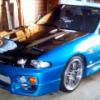Weight Difference Between Carbon Fibre And Steel?
Announcements
-
Similar Content
-
Latest Posts
-
By Harinder singh · Posted
Hi SAU family, having issues with my R34GTT which is slightly modified and tuned to e85. so scenario is, I’m driving the car to work (30km oneway) and then coming back in the arvo. Car starts and runs fine in the morning and on the way back home (in the arvo). I stop the car when i gets home and after 10-15 mins, it wont start. Battery is fine, fuel pump seems to be working. All i hear is engine clicks but wont start. Last time, i disconnected the battery terminals and re connected them. Check fuses. Didnt start at that time but started after an hour (so I say when its cool down). Mechanic cant find the issue as its running now and nothing coming up in the diagnose. any advice,opinion or anyone gone through similar issue. thanks 🙏🏻 -
9" +35 will rub on the suspension. R33 GTR wheels are +30.
-
I know a guy with 18x9 +22 on the front of a 32 gtst, needed quite a lot of guard work, tyre stretch (215) and camber. Not sure what your current set up is, +35 won't be as much, but still a fair bit of guard work and camber.
-
Well as expected the ECU wasn't getting proper manifold pressure reading. Once I switched to a 3rd vacuum line directly off the back of the manifold the car runs amazing. Still slightly lean on full throttle but only like 15 AFR, probably fixable with some tuning.
-




Recommended Posts
Create an account or sign in to comment
You need to be a member in order to leave a comment
Create an account
Sign up for a new account in our community. It's easy!
Register a new accountSign in
Already have an account? Sign in here.
Sign In Now